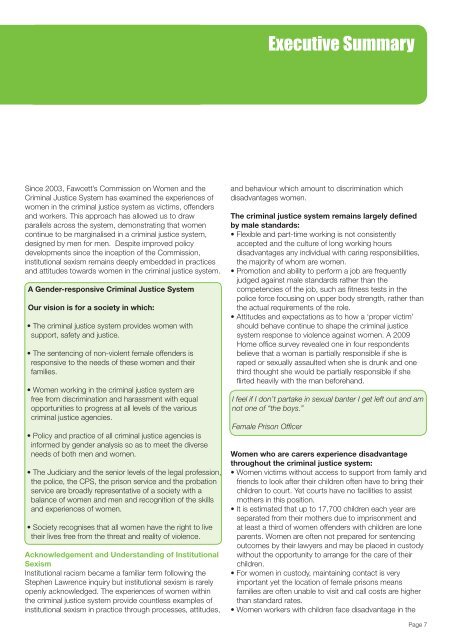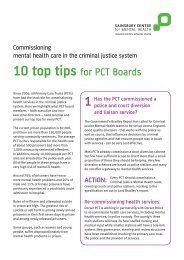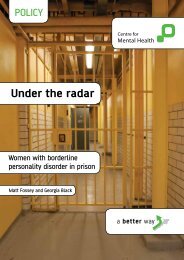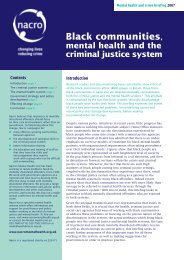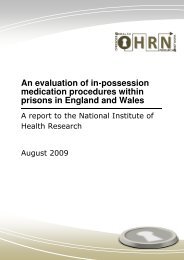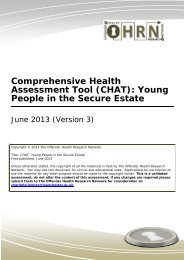Engendering Justice - from Policy to Practice - The Fawcett Society
Engendering Justice - from Policy to Practice - The Fawcett Society
Engendering Justice - from Policy to Practice - The Fawcett Society
- No tags were found...
Create successful ePaper yourself
Turn your PDF publications into a flip-book with our unique Google optimized e-Paper software.
Executive SummarySince 2003, <strong>Fawcett</strong>’s Commission on Women and theCriminal <strong>Justice</strong> System has examined the experiences ofwomen in the criminal justice system as victims, offendersand workers. This approach has allowed us <strong>to</strong> drawparallels across the system, demonstrating that womencontinue <strong>to</strong> be marginalised in a criminal justice system,designed by men for men. Despite improved policydevelopments since the inception of the Commission,institutional sexism remains deeply embedded in practicesand attitudes <strong>to</strong>wards women in the criminal justice system.A Gender-responsive Criminal <strong>Justice</strong> SystemOur vision is for a society in which:• <strong>The</strong> criminal justice system provides women withsupport, safety and justice.• <strong>The</strong> sentencing of non-violent female offenders isresponsive <strong>to</strong> the needs of these women and theirfamilies.• Women working in the criminal justice system arefree <strong>from</strong> discrimination and harassment with equalopportunities <strong>to</strong> progress at all levels of the variouscriminal justice agencies.• <strong>Policy</strong> and practice of all criminal justice agencies isinformed by gender analysis so as <strong>to</strong> meet the diverseneeds of both men and women.• <strong>The</strong> Judiciary and the senior levels of the legal profession,the police, the CPS, the prison service and the probationservice are broadly representative of a society with abalance of women and men and recognition of the skillsand experiences of women.• <strong>Society</strong> recognises that all women have the right <strong>to</strong> livetheir lives free <strong>from</strong> the threat and reality of violence.Acknowledgement and Understanding of InstitutionalSexismInstitutional racism became a familiar term following theStephen Lawrence inquiry but institutional sexism is rarelyopenly acknowledged. <strong>The</strong> experiences of women withinthe criminal justice system provide countless examples ofinstitutional sexism in practice through processes, attitudes,and behaviour which amount <strong>to</strong> discrimination whichdisadvantages women.<strong>The</strong> criminal justice system remains largely definedby male standards:• Flexible and part-time working is not consistentlyaccepted and the culture of long working hoursdisadvantages any individual with caring responsibilities,the majority of whom are women.• Promotion and ability <strong>to</strong> perform a job are frequentlyjudged against male standards rather than thecompetencies of the job, such as fitness tests in thepolice force focusing on upper body strength, rather thanthe actual requirements of the role.• Attitudes and expectations as <strong>to</strong> how a ‘proper victim’should behave continue <strong>to</strong> shape the criminal justicesystem response <strong>to</strong> violence against women. A 2009Home office survey revealed one in four respondentsbelieve that a woman is partially responsible if she israped or sexually assaulted when she is drunk and onethird thought she would be partially responsible if sheflirted heavily with the man beforehand.I feel if I don’t partake in sexual banter I get left out and amnot one of “the boys.”Female Prison OfficerWomen who are carers experience disadvantagethroughout the criminal justice system:• Women victims without access <strong>to</strong> support <strong>from</strong> family andfriends <strong>to</strong> look after their children often have <strong>to</strong> bring theirchildren <strong>to</strong> court. Yet courts have no facilities <strong>to</strong> assistmothers in this position.• It is estimated that up <strong>to</strong> 17,700 children each year areseparated <strong>from</strong> their mothers due <strong>to</strong> imprisonment andat least a third of women offenders with children are loneparents. Women are often not prepared for sentencingoutcomes by their lawyers and may be placed in cus<strong>to</strong>dywithout the opportunity <strong>to</strong> arrange for the care of theirchildren.• For women in cus<strong>to</strong>dy, maintaining contact is veryimportant yet the location of female prisons meansfamilies are often unable <strong>to</strong> visit and call costs are higherthan standard rates.• Women workers with children face disadvantage in thePage 7


